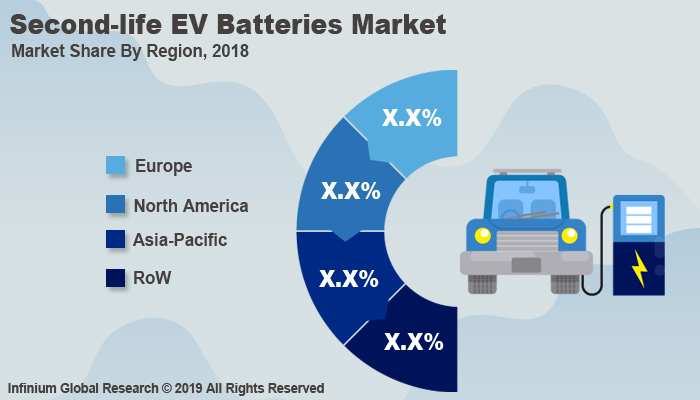Second-life EV Batteries Market (Type - Lead Acid, Lithium-ion, Nickel, Sodium-ion, and Other Types; Application - Residential Energy Storage, Commercial and Industrial Energy Storage, EV Charging, Grid Charging, and Off-grid): Global Industry Analysis, Trends, Size, Share and Forecasts to 2025
A recent report published by Infinium Global Research on
second-life EV batteries market provides an in-depth analysis of segments and
sub-segments in the global as well as regional second-life EV batteries market.
The study also highlights the impact of drivers, restraints, and macro
indicators on the global and regional second-life EV batteries market over the
short term as well as long term. The report is a comprehensive presentation of
trends, forecast and dollar values of global second-life EV batteries market.
According to the report, the global second-life EV batteries market is
projected to grow at a robust CAGR over the forecast period of 2019-2025.
Market Insight
In the near future, a large number of electric vehicle (EV)
batteries will reach their end-of-life. By 2025, around 250,000 metric tons of
EV lithium-ion batteries are expected to have reached end-of-life. However,
these batteries may still retain capacity that could be used in second life for
various applications such as home electricity storage and EV charging others.
Vehicle manufacturers such as Nissan and Renault, have launched their
second-life businesses. These companies have launched brands such as XStorage
home systems and Powervault respectively in the household energy storage market
and focus on private households with solar panels in the UK as their core
customer segment. In September 2018, Renault Group announced the launching of
its new advanced battery storage program that will work to build Europe’s
largest stationary energy system using a combination of used and new EV
batteries by 2020. The company reuses 2,000 battery packs from EV to offer a
power of 70 MW and energy amounting to 60 MWh, equivalent to the daily
consumption of a city of 5,000 households.
Currently, the second-life battery industry is at its
nascent stage and regulations might play a key role in the value and
feasibility of battery second use. The EV manufacturers are the key players in
developing the second-life EV batteries. An increase in environmental concerns
about used batteries is expected to drive the market in the forecast period.
However, the competition from new batteries constitutes a major challenge for
second-life EV batteries, which makes it crucial to establish the market and
infrastructure for second-life batteries in the near future. Innovative
business models that reduce second-life battery risks for customers are
essential for second-life batteries to compete in the energy storage market.
Residential energy storage, commercial and industrial energy storage, EV
charging, grid charging, and off-grid are key applications of the second-life
EV batteries market. Commercial and industrial energy storage applications hold
a significant share in the second-life EV batteries market. China Tower Corp
Ltd. is one of the biggest consumers of second-life EV batteries. The company
uses second-life batteries as back-up power for their 2 million telecom towers
across China. In November 2018, China Tower Corp Ltd. has signed a contract
with 11 EV manufacturers for second-life EV batteries. This will provide China
with an impetus to develop solutions and standards for retired batteries from
EV. Based on type second-life EV batteries market is bifurcated into lead-acid,
lithium-ion, nickel, sodium-ion, and other types. Among all, the lithium-ion
battery segment is anticipated to display a significant growth in the market
owing to benefits in comparison to other types.
Europe is one of the leading regions in the second-life EV
batteries market in 2018. This can be primarily ascribed to the implementation
of strict environmental regulations regarding battery disposal and recycling
across the region. The market in the Asia-Pacific is anticipated to expand at a
significant pace within the forecast period, primarily due to the increase in
demand for batteries in developing countries and growing awareness about
battery repurposing in the region. China dominated the Asia-Pacific market in
2018. China has recently announced several measures and plans to regulate the
recycling and second use of retired EV batteries. From August 2018, all EV
batteries produced in China will be given a unique ID to help track the
batteries from production throughout to sales, usage, collection, second use,
and recycling. This regulatory landscape provides insights into the regulations
and policies that are implemented to specifically address battery second use
related issues.

Segment Covered
The report on global second-life EV batteries market covers
segments such as type, and application. On the basis of type, the sub-markets
include lead acid, lithium-ion, nickel, sodium-ion, and other types. On the
basis of application, the sub-markets include residential energy storage,
commercial and industrial energy storage, EV charging, grid charging, and
off-grid.
Companies Profiled:
The report provides profiles of the companies in the market
such as Bayerische Motoren Werke AG, BYD Auto Co., Ltd., Connected Energy Ltd.,
Daimler AG, Hyundai Motor Company, Nissan Motor Co., Ltd., Relectrify Pty Ltd,
and Toyota Motor Corporation.
Report Highlights:
The report provides deep insights into the demand forecasts, market trends, and micro and macro indicators. In addition, this report provides insights into the factors that are driving and restraining the growth in this market. Moreover, The IGR-Growth Matrix analysis given in the report brings an insight into the investment areas that existing or new market players can consider. The report provides insights into the market using analytical tools such as Porter's five forces analysis and DRO analysis of second-life EV batteries market. Moreover, the study highlights current market trends and provides forecast from 2019-2025. We also have highlighted future trends in the market that will affect the demand during the forecast period. Moreover, the competitive analysis given in each regional market brings an insight into the market share of the leading players.
Please Choose One of them.